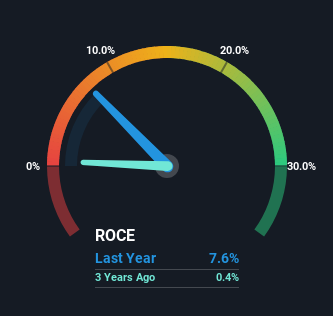- India
- /
- Entertainment
- /
- NSEI:SHEMAROO
Shemaroo Entertainment (NSE:SHEMAROO) May Have Issues Allocating Its Capital
To avoid investing in a business that's in decline, there's a few financial metrics that can provide early indications of aging. A business that's potentially in decline often shows two trends, a return on capital employed (ROCE) that's declining, and a base of capital employed that's also declining. Basically the company is earning less on its investments and it is also reducing its total assets. Having said that, after a brief look, Shemaroo Entertainment (NSE:SHEMAROO) we aren't filled with optimism, but let's investigate further.
What Is Return On Capital Employed (ROCE)?
For those that aren't sure what ROCE is, it measures the amount of pre-tax profits a company can generate from the capital employed in its business. The formula for this calculation on Shemaroo Entertainment is:
Return on Capital Employed = Earnings Before Interest and Tax (EBIT) ÷ (Total Assets - Current Liabilities)
0.076 = ₹462m ÷ (₹11b - ₹4.7b) (Based on the trailing twelve months to September 2023).
Thus, Shemaroo Entertainment has an ROCE of 7.6%. On its own, that's a low figure but it's around the 7.1% average generated by the Entertainment industry.
View our latest analysis for Shemaroo Entertainment

While the past is not representative of the future, it can be helpful to know how a company has performed historically, which is why we have this chart above. If you're interested in investigating Shemaroo Entertainment's past further, check out this free graph of past earnings, revenue and cash flow.
How Are Returns Trending?
There is reason to be cautious about Shemaroo Entertainment, given the returns are trending downwards. Unfortunately the returns on capital have diminished from the 28% that they were earning five years ago. On top of that, it's worth noting that the amount of capital employed within the business has remained relatively steady. Companies that exhibit these attributes tend to not be shrinking, but they can be mature and facing pressure on their margins from competition. If these trends continue, we wouldn't expect Shemaroo Entertainment to turn into a multi-bagger.
While on the subject, we noticed that the ratio of current liabilities to total assets has risen to 43%, which has impacted the ROCE. Without this increase, it's likely that ROCE would be even lower than 7.6%. What this means is that in reality, a rather large portion of the business is being funded by the likes of the company's suppliers or short-term creditors, which can bring some risks of its own.
The Bottom Line On Shemaroo Entertainment's ROCE
In the end, the trend of lower returns on the same amount of capital isn't typically an indication that we're looking at a growth stock. Long term shareholders who've owned the stock over the last five years have experienced a 63% depreciation in their investment, so it appears the market might not like these trends either. With underlying trends that aren't great in these areas, we'd consider looking elsewhere.
If you want to know some of the risks facing Shemaroo Entertainment we've found 4 warning signs (2 are potentially serious!) that you should be aware of before investing here.
If you want to search for solid companies with great earnings, check out this free list of companies with good balance sheets and impressive returns on equity.
New: Manage All Your Stock Portfolios in One Place
We've created the ultimate portfolio companion for stock investors, and it's free.
• Connect an unlimited number of Portfolios and see your total in one currency
• Be alerted to new Warning Signs or Risks via email or mobile
• Track the Fair Value of your stocks
Have feedback on this article? Concerned about the content? Get in touch with us directly. Alternatively, email editorial-team (at) simplywallst.com.
This article by Simply Wall St is general in nature. We provide commentary based on historical data and analyst forecasts only using an unbiased methodology and our articles are not intended to be financial advice. It does not constitute a recommendation to buy or sell any stock, and does not take account of your objectives, or your financial situation. We aim to bring you long-term focused analysis driven by fundamental data. Note that our analysis may not factor in the latest price-sensitive company announcements or qualitative material. Simply Wall St has no position in any stocks mentioned.
About NSEI:SHEMAROO
Shemaroo Entertainment
Engages in the distribution of content for broadcasting of satellite channels, physical formats and digital technologies in India.
Good value with mediocre balance sheet.
Similar Companies
Market Insights
Community Narratives




